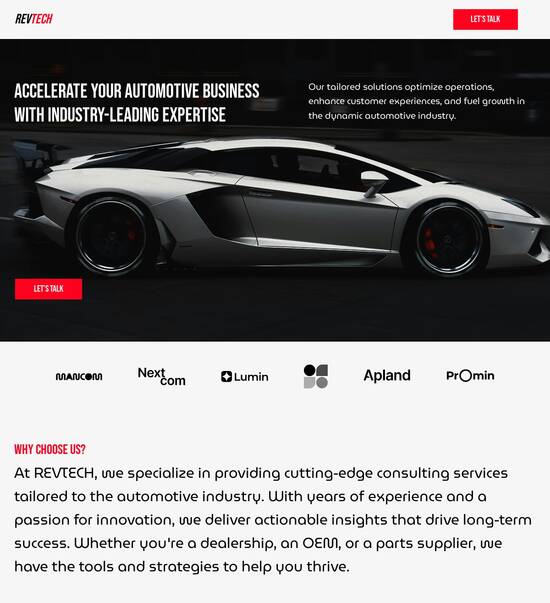
PHP optimized menu page template
Explore Similar TemplatesAbout template
Supercharge your menu page with PHP for outstanding performance! Learn more today.
Recommended templates

Easy to build without coding
With the intuitive drag-and-drop builder, anyone on your team can create high-converting pages without any knowledge of code or design. Make enhancements to your landing page with custom widgets using Javascript, HTML/CSS, or third-party scripts.

Multiple layouts for any industry and goal
Select from 500+ landing page layouts built to boost conversions across industry-specific scenarios. Customize them by adjusting fonts, adding images, and generating on-brand content with the AI assistant. Quickly scale with Instablocks® and Global Blocks that you can save, reuse, and update globally.

Loads fast and looks polished on any device
Every template is responsive, which means they present professionally on any device and load blazingly fast with our Thor Render Engine. You can also power them up with Google AMP technology to deliver an unparalleled mobile experience and drive higher conversions.

Robust analytics & experimentation
Get real-time updates and reporting across all your devices, showing the number of visitors, conversions, cost-per-visitor, and cost-per-lead. Launch AI-powered experiments, run A/B tests, and use heatmaps to analyze user behavior, then optimize your landing page to maximize conversions.







Easy to build without coding
With the intuitive drag-and-drop builder, anyone on your team can create high-converting pages without any knowledge of code or design. Make enhancements to your landing page with custom widgets using Javascript, HTML/CSS, or third-party scripts.
Multiple layouts for any industry and goal
Select from 500+ landing page layouts built to boost conversions across industry-specific scenarios. Customize them by adjusting fonts, adding images, and generating on-brand content with the AI assistant. Quickly scale with Instablocks® and Global Blocks that you can save, reuse, and update globally.
Loads fast and looks polished on any device
Every template is responsive, which means they present professionally on any device and load blazingly fast with our Thor Render Engine.
Robust analytics & experimentation
Get real-time updates and reporting across all your devices, showing the number of visitors, conversions, cost-per-visitor, and cost-per-lead. Launch AI-powered experiments, run A/B tests, and use heatmaps to analyze user behavior, then optimize your landing page to maximize conversions.
All the features you need to build lead-generating landing pages
Explore more featuresLearn how to build top-performing landing pages for any goal
FAQs
Leading the way in building high-performing landing pages





A step-by-step guide to mastering Instapage for landing pages
Creating effective landing pages is essential for maximizing ROI in your digital marketing campaigns. Instapage offers the most comprehensive platform for building high-converting landing pages tailored specifically for marketers across diverse industries including tech, education, and financial services. This guide will walk you through the critical steps needed to leverage Instapage's powerful features to accelerate your campaign success.
Understanding the basics of Instapage
Before diving into creating landing pages, it’s essential to understand the fundamental capabilities of Instapage. This platform not only provides an array of high-converting templates but also boasts advanced features that enable optimization and personalization, catering specifically to marketers in the USA. By integrating collaboration tools, you can streamline the page production process and enhance your team’s efficiency.
- High-converting templates: Access over 100 customizable landing page templates designed to drive engagement.
- Optimization tools: Utilize A/B testing and heatmaps to measure user interactions and refine your strategy.
- Personalization capabilities: Create tailored content for specific audience segments to improve user experience.
Step 1: Choosing the right template
The first step in leveraging Instapage is selecting a template that aligns with your campaign goals. Here’s how you can choose wisely:
- Consider your audience: Choose templates that resonate with your target market in the business services or tech sector.
- Focus on conversion: Opt for layouts designed for lead capture and conversions.
- Test variation: Don’t hesitate to tweak templates to better fit your branding or messaging.
Step 2: Optimize your landing page
With your template in place, the next step is ensuring it's optimized for maximum conversion.
- Implement A/B testing: Experiment with different headlines, visuals, and CTAs to find what works best.
- Utilize heatmaps: Gain insights on user behavior to identify areas for improvement.
- Monitor analytics: Use Instapage’s dashboard to track traffic sources and conversion rates.
Step 3: Personalize user experience
To maximize engagement, incorporate personalization strategies into your pages. This can make a significant difference in conversion rates.
- Dynamic text replacement: Tailor your messaging based on the audience segment visiting your page.
- AdMaps integration: Align your ads with personalized landing experiences to improve relevance.
- Audience metrics tracking: Use data tools to measure how different audience segments interact with your pages.
By following these foundational steps with Instapage, you can create effective landing pages that enhance your marketing efforts and contribute to higher ROI.
Ready to take your landing pages to the next level? Start using Instapage today and transform the way you approach digital marketing!
PHP Optimized Menu Page Template: Enhancing User Experience and Performance
Understanding the functionality of PHP optimized menu page template
A PHP optimized menu page template refers to a set of predefined structures and scripts that facilitate dynamic website navigation using PHP. PHP, a widely-used server-side scripting language, enables developers to build interactive and robust web applications. The significance of a menu page template lies in its ability to offer clear pathways for users to navigate a site, enhancing the overall user experience. Furthermore, optimization plays a crucial role in boosting performance, ensuring that menus load swiftly, thereby keeping users engaged.
The importance of a well-structured menu cannot be overstated. It serves as a roadmap for visitors, guiding them through various sections of a website. By optimizing a menu template with PHP, developers can take advantage of advanced features which cater not only to the performance needs of the site but also enhance usability. For instance, a fast-loading menu can significantly reduce bounce rates, leading to higher user retention and satisfaction.
Improved navigation experiences for users.
Increased site performance and load speed.
Enhanced SEO effectiveness through optimized structures.
Key features of PHP optimized menu page templates
PHP optimized menu page templates offer a range of features aimed at enhancing the user interface and functionality of a website. One of the standout features is the dynamic loading of menu items. This means that rather than hard-coding all items into the HTML, PHP can generate them based on content retrieved from a database. This approach not only saves time during updates but also allows for more manageable site maintenance.
Customizability is another key feature of PHP menus. Templates can be tailored to fit various industry needs, allowing for a higher degree of personalization in the user experience. Whether in the financial services, tech, or education sectors, a segmented menu can cater to specific audience demographics, making navigation more intuitive. Moreover, using optimized structures can also augment SEO. Well-organized menus facilitate better indexing by search engines, leading to improved visibility and search engine results.
The role of content and template in PHP optimization
When creating a PHP optimized menu template, structuring effective content is imperative. A well-organized menu must incorporate key elements like clear headings, informative subheadings, and prominent calls to action. These components help visitors quickly understand where to go next, contributing to a frictionless browsing experience. The language used in menu labels should not only be concise but also immediately indicative of the content available within the links.
Besides content structuring, designing a user-centric template is equally important. Different layout options, such as horizontal, vertical, dropdown, or mega menus, can be employed based on user expectations and site design. A/B testing various templates can further aid businesses in assessing which designs resonate best with their audience, thereby maximizing engagement and enhancing user satisfaction.
Technological foundations underpinning PHP menu templates
Creating an optimized menu page template necessitates a solid coding environment. Key PHP functions play a critical role in the efficient creation of menus as they handle data retrieval and rendering effectively. This integration with HTML and CSS is essential to ensure that menus not only function as intended but also align stylistically with the overall web design.
Advanced technologies such as AJAX can be incredibly beneficial for enhancing menu functionality. By allowing seamless updates and interactions without the need to reload pages, user experiences can become significantly smoother. Additionally, implementing responsive design techniques helps ensure that menus perform optimally across various devices, particularly mobile phones, aligning with the growing demand for mobile usability.
Leveraging communities for PHP menu optimization
Engaging with developer collectives is an essential aspect of mastering PHP menu optimization. Collaborative knowledge sharing facilitates the exchange of innovative approaches and solutions among developers. Online forums and coding communities offer invaluable resources, including code snippets, troubleshooting tips, and expert advice. Utilizing these platforms can significantly streamline the development process and avoid potential pitfalls that may arise during implementation.
In addition to forums, Q&A platforms like Stack Overflow serve as excellent avenues for seeking advice and sharing insights. Asking thoughtful questions and providing detailed answers helps contributors establish a reputable presence in the community. By building a knowledge base through such interactions, developers can not only enhance their skills but also stay updated with the latest trends in PHP menu optimization.
Enhancing functionality through teams and frameworks
Creating a user-friendly PHP optimized menu page template often requires a collaborative approach. Cross-functional teams involving designers, developers, and content strategists ensure that all elements come together effectively. Each team member plays a critical role in crafting intuitive navigational structures, ultimately contributing to a cohesive user experience.
Moreover, adopting agile methodologies allows for iterative design processes, meaning teams can quickly adapt to feedback and make enhancements on the fly. Popular frameworks like Laravel and Symfony provide robust foundations for building dynamic PHP menus. Utilizing these frameworks simplifies the development process, allowing for quicker implementation and integration of advanced features that enhance usability.
Performance measurement and optimization strategies
Collecting user data and feedback is vital for assessing the effectiveness of a PHP optimized menu. Tools such as Google Analytics and Hotjar enable site owners to track user behavior and gain insights into navigation patterns. Understanding how users interact with menus allows businesses to make informed decisions that directly influence design adjustments.
Analyzing performance metrics is equally essential. Key metrics to review include click-through rates, navigation paths, and exit rates. By systematically evaluating this data, website owners can continuously refine menu designs, ensuring that user engagement remains consistent. Utilizing performance insights ensures that menus evolve alongside user expectations and technological advancements.
Innovative concepts in menu design
Emerging technologies such as AI and machine learning present exciting potential for personalizing navigation experiences. By analyzing user behavior patterns, these technologies can suggest optimized menu structures tailored to individual preferences. This forward-thinking approach enhances user satisfaction and encourages longer site visits.
Exploring interactive and contextual menus further elevates user engagement. Features such as hover effects, animations, and transitions not only make navigation visually appealing but can also aid in guiding user actions. Adapting menu options dynamically based on factors such as user location or previous interactions adds a personalized touch, fostering a connection between the user and the website.
Addressing common questions and challenges
Common questions surrounding PHP menu implementation often pertain to security, compatibility, and performance issues. Ensuring that menus are securely coded prevents vulnerabilities that may be exploited. Regularly updating scripts and frameworks will also help maintain compatibility with evolving technologies.
Effective troubleshooting solutions include reviewing code for errors, analyzing server responses, and optimizing backend integration. By implementing best practices from successful case studies, businesses can navigate potential challenges with greater ease. Companies that have effectively implemented PHP optimized menus often report benefits in user engagement, conversion rates, and overall satisfaction.
Future outlook for PHP optimized menu page templates
User expectations regarding web design are constantly evolving. Upcoming trends may lean towards more interactive menus that provide immediate feedback and adapt to visitor choices. As technological advancements unfold, preparing for shifts in usability and design preferences will be key in maintaining a competitive edge.
Implementing feedback loops remains crucial in the ongoing improvement of menu designs. Continual user feedback combined with behavior analytics can guide developers in making critical adjustments that enhance functionality. As businesses fine-tune their PHP optimized menu templates, ensuring that they remain responsive to user needs will ultimately determine their success.
Ready to skyrocket conversions?
Supercharge your ad campaigns with high-performing landing pages
Get started














